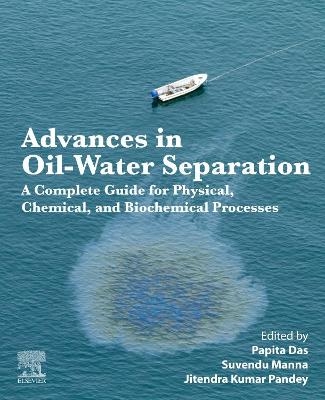
Advances in Oil-Water Separation
Elsevier - Health Sciences Division (Verlag)
978-0-323-89978-9 (ISBN)
As the book provides a complete state-of-art overview on oil-water separation technologies, it will also ease literature searches on oil-water separation technologies.
Prof. (Dr) Papita Das is Professor, Department of Chemical Engineering and Director, School of Advanced Studies in Industrial Pollution Control Engineering, Jadavpur University, Kolkata. She has expertise in highly topical domains of chemical engineering related to Environmental Pollution Control. The research done in her laboratory addresses known and emerging environmental concerns that continues to plague us, with an emphasis on clay-based liner materials, nanoparticles, bio-polymeric film for the clean-up of contaminated soil, water, and other environmental compartments. Over the years, her research team has made notable contributions on several key areas related to “Environmental Sustainability, which have been recognized with various awards in recent years. Further, her research has produced over 175 International Journal publications, 50+ Book Chapters, 12 Books, 2 Edited Books and 100+ Conferences which have been well received by the global scientific community. Dr. Suvendu Manna received his PhD in wastewater treatment in 2015. He is an assistant professor in University of Petroleum and Energy Studies, Dehradun, India. Dr. Manna authored or co-authored more than 20 international research and review articles in SCI- and Scopus- indexed journals. He has also written more than 11 book chapters. Professor Jitendra Kumar Pandey is a professor in University of Petroleum and Energy Studies, Dehradun, India. He completed his PhD in chemistry, and his research interests include materials synthesis, characterizations and their application in energy storage, and water treatment. He has published more than 50 research articles and reviews in peer-reviewed journals.
Section A: Overview on oil pollution and its effect on environment 1. An overview of oil pollution and oil-spilling incidents 2. Spatio-temporal distribution of Oil spill effect in the estuarine terrain of Bhagirathi-Hooghly river, West Bengal, India 3. Oil pollution and municipal wastewater treatment: issues and impact 4. Overview on worldwide regulations on oil pollution control 5. Technological aspects of different oil and water separation advanced techniques 6. Impact analysis of oil pollution on environment, marine and soil communities 7. Impact of Oil Exploration and Spillage on Marine Environments
Section B: Physical processes 8. Super-hydrophobic polymeric adsorbents as an efficient oil separator 9. Oil Spill Treatment Using Porous Materials 10. Nanotechnological advances for oil spill management: Removal, recovery and remediation 11. Carbon nanotube (CNT) based oil-water separation 12. Nanocoated membrane for oil treatment
Section C: Thermo-chemical processes 13. Chemical Stabilisation of oil by elastomizers 14. Advances in burning processes and their impact to the environment 15. Use of chemical dispersants for management of oil pollution 16. Use of emulsifier as the agent for oil spill mitigation
Section D: Biological processes 17. Use of live microbes for oil degradation in-situ 18. Metagenomics- An Approach for Selection of Oil Degrading Microbes and its Application in Remediation of Oil Pollution 19. Potentiality of Enzymes as a green tool in Degradation of Petroleum Hydrocarbons 20. Bioremediation: an ecofriendly approach for the treatment of oil spills 21. Bioremediation of black tides: Strategies involving genetically modified organisms 22. Microbes and marine oil spills: Oil-eating bugs can cure oily sea-sickness 23. Hybrid biological processes for the treatment of oily wastewater
Section E: Miscellaneous 24. Efficient management of oil waste: Chemical and physiochemical approaches 25. Membrane bioreactors for the treatment of oily wastewater: pros and cons 26. Overview on natural materials for oil water separation 27. Extraction and separation of oils: the journey from distillation to pervaporation
| Erscheinungsdatum | 08.03.2022 |
|---|---|
| Zusatzinfo | Approx. 150 illustrations; Illustrations |
| Verlagsort | Philadelphia |
| Sprache | englisch |
| Maße | 191 x 235 mm |
| Gewicht | 910 g |
| Themenwelt | Naturwissenschaften ► Biologie ► Mikrobiologie / Immunologie |
| Naturwissenschaften ► Chemie ► Technische Chemie | |
| Technik ► Umwelttechnik / Biotechnologie | |
| ISBN-10 | 0-323-89978-1 / 0323899781 |
| ISBN-13 | 978-0-323-89978-9 / 9780323899789 |
| Zustand | Neuware |
| Informationen gemäß Produktsicherheitsverordnung (GPSR) | |
| Haben Sie eine Frage zum Produkt? |
aus dem Bereich


